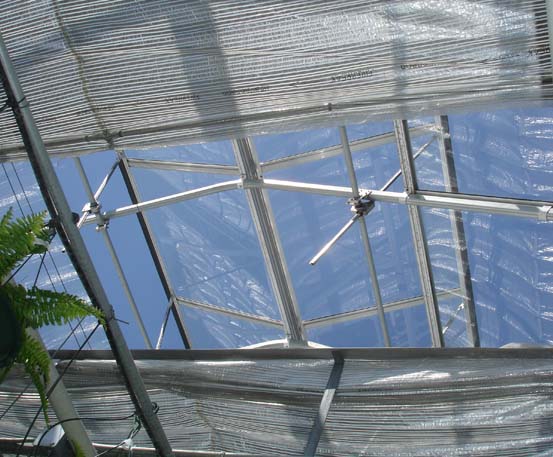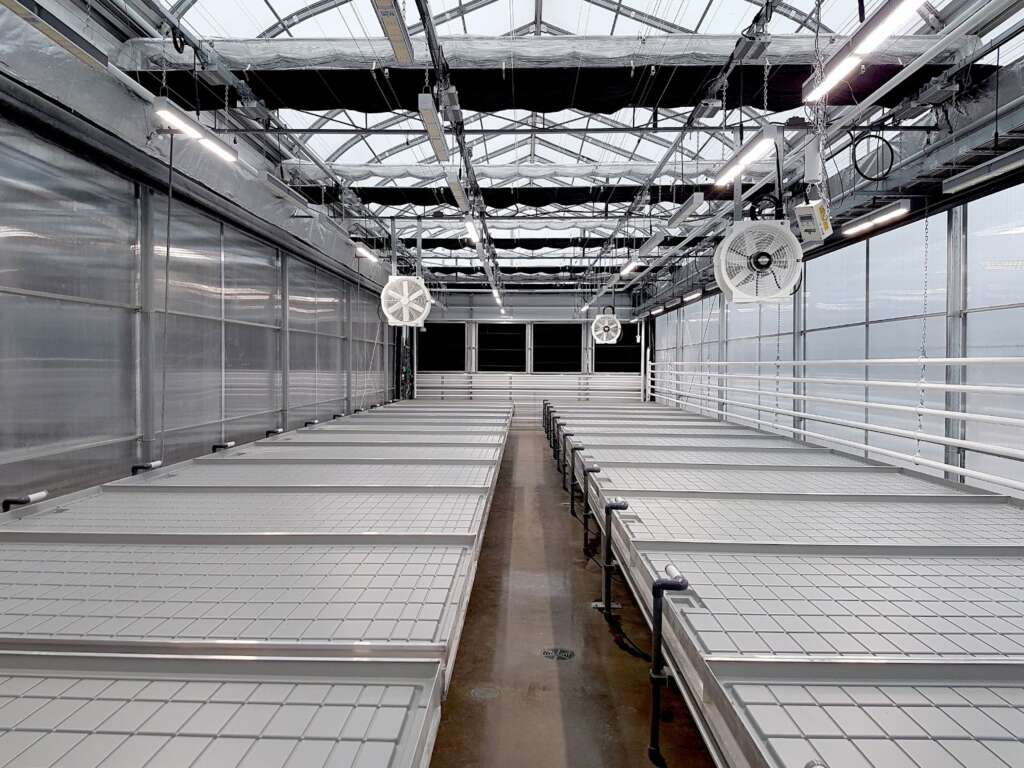Launching or expanding a greenhouse operation is an exciting opportunity, but also a serious investment. Whether you’re producing vegetables, ornamentals, or another specialty crop, the long-term success of your greenhouse depends on careful planning, smart design, and having the right systems in place from day one. Learning how to build a greenhouse the right way ensures every decision supports long-term profitability.
We’ve worked with growers across the world to design greenhouse facilities that maximize efficiency, crop quality, and profitability. Over the years, one thing has become clear: the most successful growers treat their greenhouse like a finely tuned system, not just a building with plants inside. From selecting the right greenhouse covering materials to installing efficient irrigation systems, every component plays a role in success.
This checklist is designed to help you think through the essentials you need to build a high-performing greenhouse operation, from infrastructure and environment control to workflow and future scalability.
1. Clear Goals and Business Plan
Before breaking ground, ask yourself: What am I trying to achieve?A greenhouse designed for leafy greens looks very different from one designed for, vegetables, cut flowers or cannabis. Your business plan should outline:
- Target crops and markets– What will you grow, and who are your customers?
- Production scale– How much yield do you need to break even and scale profitably?
- Budget and financing– What can you invest upfront, and how will you fund expansion?
- Labor needs– How many staff will be required to operate daily and seasonally?
Starting with clear goals ensures that every design and equipment decision aligns with your long-term vision.
2. Greenhouse Structure
The backbone of your operation is the greenhouse itself. A well-designed structure provides the right balance of light transmission, durability, climate control, and workflow efficiency. For growers learninghow to build a greenhouse, choosing the right structure is one of the most important steps.
When choosing a greenhouse design, consider:
- Frame type:Gutter-connected ranges offer scalability, while freestanding houses are flexible for smaller operations.
- Covering materials: Poly film, polycarbonate, or glasseach offer different light diffusion, insulation, and durability benefits. Selecting the right greenhouse covering materialsensures efficiency and crop protection
- Orientation:Maximize sunlight exposure and reduce shading from surrounding buildings or trees.
- Strength and climate suitability:Ensure your greenhouse can withstand local wind, snow, and temperature extremes.
At GGS, we design custom structures that adapt to your specific climate, crops, and expansion plans, so your greenhouse can grow with your business.
3. Climate Control Systems
Plants thrive within precise environmental conditions, and high-performing operations invest in systems that maintain consistency. The key components include:
- Heating:Boilers, unit heaters, or radiant floor heating help maintain target temperatures in cold climates.
- Cooling:Options include natural ventilation, evaporative cooling, orhigh-tech HVAC systemsdepending on crop sensitivity.
- Ventilation:Roof vents, roll-up sides, orhorizontal airflow fanskeep air circulating, reducing humidity pockets, disease risk and mold and mildew.
- Shade systems:Retractable curtainsprotect crops from excessive heat and optimize photoperiod control.
The right combination depends on your crops and regional climate. The more precise your climate control, heating, cooling, andirrigation systems, the more predictable your crop outcomes.

4. Lighting Solutions
Natural sunlight is often not enough for consistent year-round production. Supplemental lighting, and in some cases full LED setups, areessential for optimizing growth.
When evaluating lighting:
- LED vs. HPS:LEDs offer long-term energy efficiency and spectral control, while HPS systems provide proven, cost-effective intensity.
- Uniformity:Lighting should be evenly distributed across the crop canopy to avoid uneven growth.
- Integration with photoperiod:Ensure that your lighting system supports the crop’s natural growth cycle and your production schedule.
Many growers see dramatic improvements in yield and quality when they optimize their lighting strategy.
5. Irrigation and Fertigation
Water and nutrients are the lifeblood of your crops. Investing in a reliable and efficient irrigation system ensures consistency and reduces waste.
Options include:
- Drip irrigation:Direct, efficient delivery of water and nutrients to the root zone.
- Overhead misting:Useful for propagation and humidity control.
- Ebb-and-flow benches:Excellent for ornamentals and small potted crops.
- Automated fertigation:Delivers precise nutrient mixes, improving uniformity and saving labor.
Monitoring water quality and nutrient balance is equally important.A fertigation system integrated with sensors and controls can help optimize growth while reducing input costs.
6. Growing Systems and Benching
How you arrange your plants within the greenhouse directly impacts space efficiency, workflow, and crop quality.
- Stationary benches:Affordable and straightforward, ideal for small to mid-scale operations.
- Rolling benches:Maximize usable space by reducing aisles.
- Multi-level racking:For crops like microgreens, vertical growing systems can multiply your yield per square foot.
- Hydroponic systems:NFT channels, deep-water culture, or aeroponics may be suitable depending on your crop and expertise.
An efficient layout reduces labor costs, maximizes crop density, and creates a smoother workflow.

7. Integrated Pest Management (IPM) Plan
Pests and diseases are one of the biggest risks to any greenhouse. A high-performing operation incorporates preventative and responsive pest managementstrategies, such as:
- Sanitation protocolsto reduce entry points for pests.
- Biological controlslike beneficial insects or microbes.
- Environmental adjustments(humidity, airflow) to make conditions less favorable for pests.
- Monitoring toolslike sticky cards and scouting routines.
A proactive IPM plan not only protects your crops but also supports sustainability by minimizing chemical reliance.
8. Automation and Controls
High-performing operations increasingly rely on automation to reduce labor costs and improve precision. Consider:
- Environmental control systems:Centralized software to monitor and adjust temperature, humidity, CO₂, and lighting.
- Irrigation and fertigation automation:Delivers consistent nutrient solutions on schedule.
- Data logging and sensors:Provides real-time insight into crop conditions and system performance.
Automation helps growers scale without dramatically increasing labor needs and ensures consistency across crop cycles.
9. Workflow and Labor Efficiency
Greenhouse design isn’t just about plants, it’s about people. A successful facility is designed to minimize wasted movement and maximize productivity.
- Wide aisles and accessible layoutsreduce time spent maneuvering carts or equipment.
- Ergonomic workstationshelp with potting, transplanting, and harvesting.
- Internal transport systemslike conveyors, rolling benches, or overhead rails reduce labor-intensive handling.
The smoother the workflow, the more cost-effective your operation becomes.
10. Compliance and Safety
Greenhouses are regulated environments, and compliance should never be an afterthought. Be sure to account for:
- Building codes and permitsfor structural integrity.
- Worker safety protocolssuch as proper ventilation for chemical use.
- Crop-specific regulations(e.g., cannabis production requires strict compliance with local laws).
- Food safety standardsif producing edibles.
Integrating compliance from the start prevents costly retrofits or legal challenges later.
11. Scalability and Expansion Planning
Your greenhouse should meet today’s needs and tomorrow’s ambitions. Many successful operations grow incrementally, expanding as markets and demand increase.
Design your greenhouse with:
- Expandable baysthat allow for seamless connection of new ranges.
- Modular equipmentthat can be scaled up or automated over time.
- Infrastructure capacity(utilities, water, HVAC) sized to handle future growth.
This foresight saves time, money, and headaches when you’re ready to expand.
12. Partnering with the Right Experts
Learning how to build a greenhousethat truly performs is a complex process, and no grower needs to do it alone. Working with experienced greenhouse manufacturers, engineers, and consultants ensures your facility is designed and built for long-term success.
At GGS, we partner with growers at every stage, from initial design and engineering to equipment selection,irrigation systems, and installation. With decades of expertise across multiple industries, we help growers turn their vision into a thriving operation.

